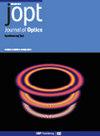具有双宽带完美吸收功能的超薄水基超表面
IF 2.7
4区 物理与天体物理
Q3 OPTICS
引用次数: 0
摘要
5 G 技术的快速发展归功于其在 600 MHz 至 6 GHz 低频段的出色渗透力,尤其是在 700 MHz、2.3 GHz 和 3.5 GHz 等特定频率范围。同时,该技术在 24 GHz 至 52 GHz 的毫米波频谱中表现出色,特别是在 24.25-27.5 GHz 和 37-40 GHz 等频段,展现出令人印象深刻的高速数据传输能力。然而,这些信号在实际应用中经常会受到电子设备的电磁干扰,从而影响通信质量。为了解决这些问题,本文介绍了双宽带超薄水基超表面吸收器(WBMA)的设计、制造和测量方法。该单元由一个 4 毫米厚的光刻胶外壳、水层和金属板组成,水层内有一个不规则的八角棱柱和一个矩形环形空腔。仿真和实验结果表明,在 4.2 GHz 至 4.8 GHz 和 23.6 GHz 至 51.1 GHz 的横向电模式频率下,拟议的元表面实现了近乎完美的吸收。此外,在 4.3 GHz 至 4.9 GHz 和 23.2 GHz 至 50.8 GHz 的频率范围内,拟议的元表面在横向磁模式下的吸收率超过 90%。所设计的水基元表面还具有极化不敏感和可处理广角入射的特点。对元表面内部电场和磁场分布的分析表明,吸收机制是由水层结构内部的强磁共振驱动的。此外,还探讨了超材料吸收器的有效阻抗。鉴于其独特的吸收频段,所提出的 WBMA 有可能应用于 5G 通信领域。本文章由计算机程序翻译,如有差异,请以英文原文为准。
Ultra-thin water-based metasurface with dual-broadband perfect absorption
The rapid development of the 5 G technology can be attributed to its outstanding penetration in the low frequency bands ranging from 600 MHz to 6 GHz, particularly in specific frequency ranges like 700 MHz, 2.3 GHz, and 3.5 GHz. Simultaneously, the technology excels in the millimeter-wave spectrum, spanning from 24 GHz to 52 GHz, notably in bands such as 24.25–27.5 GHz and 37–40 GHz, showcasing impressive capabilities for high-speed data transmission. Nevertheless, these signals frequently encounter electromagnetic interference from electronic equipment in practical applications, which compromise the quality of communication. To address these issues, this paper presents the design, fabrication, and measure of a dual-broadband ultra-thin water-based metasurface absorber (WBMA). The unit cell is composed of a 4 mm thick photoresist shell encasing a water layer and metal plate, and features an irregular octagonal prism and a rectangular annulus cavity within the water layer. Simulation and experimental outcomes indicate that the proposed metasurface achieves near-perfect absorption at frequencies from 4.2 GHz to 4.8 GHz and from 23.6 GHz to 51.1 GHz in the transverse electric mode. Additionally, the proposed metasurface exhibits more than 90% absorption in the transverse magnetic mode for frequency ranges from 4.3 GHz to 4.9 GHz and from 23.2 GHz to 50.8 GHz. The designed water-based metasurface also exhibits features of polarization insensitivity and capability to handle wide-angle incidence. Analysis of the electric and magnetic field distribution within the metasurface suggests that the absorption mechanism is driven by strong magnetic resonance within the water layer’s structure. Furthermore, the effective impedance of the metamaterial absorber is explored. Given the unique absorption frequency bands, the proposed WBMA has potential applications in the realm of 5G communication.
求助全文
通过发布文献求助,成功后即可免费获取论文全文。
去求助
来源期刊

Journal of Optics
OPTICS-
CiteScore
4.50
自引率
4.80%
发文量
237
审稿时长
1.9 months
期刊介绍:
Journal of Optics publishes new experimental and theoretical research across all areas of pure and applied optics, both modern and classical. Research areas are categorised as:
Nanophotonics and plasmonics
Metamaterials and structured photonic materials
Quantum photonics
Biophotonics
Light-matter interactions
Nonlinear and ultrafast optics
Propagation, diffraction and scattering
Optical communication
Integrated optics
Photovoltaics and energy harvesting
We discourage incremental advances, purely numerical simulations without any validation, or research without a strong optics advance, e.g. computer algorithms applied to optical and imaging processes, equipment designs or material fabrication.
 求助内容:
求助内容: 应助结果提醒方式:
应助结果提醒方式:


